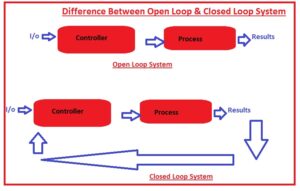 Hello, friends, I hope you all are doing great. In today’s tutorial, we will discuss the Difference Between Open Loop & Closed Loop System. in an open-loop system there is no influence of control action on the open-loop system. But in closed-loop system control action has influence or required output depends on the control action.
Hello, friends, I hope you all are doing great. In today’s tutorial, we will discuss the Difference Between Open Loop & Closed Loop System. in an open-loop system there is no influence of control action on the open-loop system. But in closed-loop system control action has influence or required output depends on the control action.
In today’s post, we will have a detailed look at both open and closed-loop systems with the detailed and compare them to discuss their differences. So let’s get started with Difference Between Open Loop & Closed Loop System.
Difference Between Open Loop & Closed Loop System
Open Loop System
- An open-loop system also named nonfeedback controller means there is not control of output at the input.
- There is no feedback given to the input side.
- Its practical example is on and off the process of tap, different machines motors operation
- It does not have the ability to reduce any error occur
- An example of open-loop is boiler control the use of timer when its desired option gets timer off it
- Its prices is less and simple circuitry and easy to maintain
- A cloth dryer is an open-loop system
- It employed in such applications where complications structure are needed like a simple process and fewer prices.
- The simple example where it used is your home cloth dries that is controlled y the users not needed certain arrangements to operate.
- There is another example is irrigation sprinter operation that measures the moisture in the field
- This system is more stable than the closed system.
- It can not be optimized.
- The elements of this system are Controller and the Controlled Process.
- It construction is less complicated than the closed-loop system.
- Its reliability is less than the closed-loop system.
- Its accuracy relies on calibration.
Closed-Loop System
- Such a system whose resultant output depends on the control action of the system is called a closed-loop system.
- It also is known as a feedback system.
- The main elements of this system are the Amplifier, Controller, Controlled Process, Feedback.
- Its physical structure is more complicated than the open-loop system.
- Its response time is less than the open-loop system.
- It can be easily calibrated and there is no need for certain modification
- The disturbance of the system does not affect the closed-loop system.
- It is a linear system and all results are shown at the single graphical line
- Its reliability is larger than the open-loop system.
- Its accuracy is largely due to the use of feedback. that effect eh overall results and give better output
- Its stability is less than the open-loop system the main cause is to given the feedback to the input
- The example of this system is the Air conditioner, temperature control system, speed, and pressure control system.
That is all about the difference between open loop and closed-loop system. If you have any query ask in comments. Thanks for reading. Have a good day.






